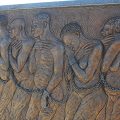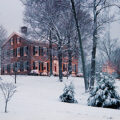By Renée S. Gordon
“Now I ask you, had you not rather be killed than to be a slave to a tyrant, who takes the life of your mother, wife and dear little children?”
–David Walker 1829
The Underground Railroad (UGRR) was, of necessity, generally a clandestine group of loosely organized individuals and organizations that assisted fugitives escaping bondage. This group, the first international, intergenerational, interdenominational, interracial protest movement, is credited with facilitating the emancipation of an estimated 100,000 individuals. In certain areas, entire communities supported the UGRR not only providing safe haven but also raising money and supplying food and clothing.
The location of stations was determined by geography, individual and community political sentiments and at some point the lexicon of the railroad was adopted and terms such as stationmasters, conductors, stations, packages and agents appear to have been in common use. One of the earliest documented references appeared in a Chicago newspaper in 1844. A cartoon drawn by an abolitionist, “The Liberty Line,” depicts several fugitives aboard a train bound for Canada.
Because the vast majority of the freedom seekers were illiterate tales of escape were taken from autobiographies and journals of abolitionists written long after the fact and from a single of viewpoint. Narratives by fugitives are scarce, an exception being a book published by Philadelphia’s William Still in 1872. It contains first hand accounts by fugitives collected during the course of his work as a stationmaster.
Northern Kentucky’s Heritage Trails interpret the stories of the abolitionists, the fugitives and the black communities engaged in the industry of freedom. The state has 150-miles of shoreline and patrollers, referred to as “paddy rollers,” were assigned to guard a 15- to 20-mile area. As you drive through the small towns that line the river, one can imagine the courage and desperation of those who reached this point on their journey. www.nkycvb.com
Covington, Kentucky to Cincinnati, Ohio was one of the UGRR’s major crossing points and the escape upon which Toni Morrison based her book “Beloved” occurred here.
Margaret and Robert Garner and their four children escaped from Maplewood Plantation, just south of Covington, across the frozen Ohio River in 1856. When she realized her pursuers were close and capture inevitable she cut the throat of her 2-year old daughter and wounded the others to prevent their return to enslavement. There is speculation that the slave-owner fathered three of the children and at her trial testimony regarding sexual abuse was given. Margaret’s owner eventually sent her deeper south.
The “Rivers, Roads, Rails and Runways” history exhibit in the Behringer-Crawford Museum begins with a 7-minute orientation video and proceeds through a series of galleries on four levels with a total of 20,000-sq. ft. of space. The foundation of the collection is a series of archeological artifacts that include items from prehistoric native cultures.
The displays are outstanding with several notable interactive areas, a 1959 Buick Electra you can sit in and see a movie, a replica of the Roebling Bridge you can walk on and stunning stained glass works by Wolfgang Ritschel. A tour highlight is a permanent train display with a glass bubble in the center that allows you to be in the middle of the action. www.bcmuseum.org/bcmuseum
The museum is part of the 700-acre Devou Park complex that includes an 18-hole golf course, bandshell, gardens and panoramic views of Covington and Cincinnati. www.covingtonky.com
St. Mary’s Cathedral Basilica of The Assumption is a magnificent 14,322-sq. ft. structure, built on quicksand floated on a concrete foundation, constructed of brick and Indiana limestone modeled after European cathedrals. The west façade has three portals and around the exterior of this Gothic edifice are 26 gargoyles. There are two rose windows, one with a 26-ft. diameter.
The interior of the 180-ft. long cathedral is a marvel of stained glass windows, gilt and handcarved accoutrements. The 14 Stations of the Cross are Venetian mosaics each comprised of between 70,000 to 80,000 tiles with mother-of-pearl and gold highlights. The last station is so finely crafted that the tears in Christ’s mother’s eyes appear translucent. The cathedral was dedicated in 1910. There is a fee for guided tours but entrance is free. www.covcathedral.com
One of the most unique places in the area is not a historic house but a restaurant, the Hofbrauhaus at 3rd & Saratoga in Newport. It is the first authentic German Hofbrauhaus in the U.S. It is an exact duplication of the 400-year old beer garden in Munich. Beer is brewed on the premises, the food is great, there is live entertainment daily and guests are encouraged to join in the frivolity. www.hofbrauhausnewport.com
Burlington, KY is the site of the 80-acre Dinsmore Homestead Farm. James and Martha McComb moved here from Louisiana in 1839 and erected this Greek revival home with a French Creole rear in 1842. More than 60 enslaved people worked here and records indicate that only one ever escaped. She left after the Civil War but returned years later when she was ill and the family allowed her to live there until her death in 1906.
Dinsmore is historically significant for several reasons. The family maintained copious records in the form of letters, journals, diaries, business papers and legal records totaling more than 90,000 pages. These papers shed light on domestic life and the era.
Both the family and a slave graveyard are on the property and can be visited. Martha Ferguson was raised at Dinsmore and cared for by an African American woman named Julia Farley Loving. Julia was buried in the family graveyard and on Martha’s death she requested that she be cremated and her ashes placed in Julia’s grave. Julia’s initial tombstone was inscribed “Mammy” but was later changed to her name.
Tours of the homestead interpret the life of the family, the enslaved and that of Harry, a black caretaker who maintained the house from the 20s to the 1950s. www.dinsmorefarm.org
Rabbit Hash, Kentucky, at mile # 506 on the Ohio River, is a real treat. This 19th-century river town has maintained its appearance and the general store has been in operation since 1831. It was known as Carlton until the flood of 1847 forced the local population to eat an abundance of rabbit hash. The 3.5-acre town and surrounding 33-acres have been designated a National Landmark. www.rabbithashusa.com
General Butler State Resort Park is the site of the 1859 Butler-Turpin House. The 2-story Greek revival mansion, constructed with slave labor, was home to several generations. William Butler was the first person in the region to liberate his slaves. House tours tell the story of the Butlers and the Turpins, subsequent owners who held 85 slaves. There are Butler items in each room and the house has been the scene of documented paranormal events. The resort park was Kentucky’s first and it sits on 300-acres of the Butler homestead. www.parks.ky.gov
Farmington Historic Plantation was completed in 1816. This 6,000-sq. ft home has 10 fireplaces and 16-ft ceilings. It was the home of Joshua Speed, Lincoln’s best friend, and was the site of 32-year old Lincoln’s first prolonged stay on a slave plantation. At one point, there were 20 workers, 18 enslaved and 2 freemen but the number rose as high as 60 enslaved. Tours include the family rooms and the areas used by the enslaved. On the grounds, there is a beautiful monument “In Memory of the Enslaved African Americans at Farmington.” This is a don’t miss tour. www.farmingtonhistorichome.org
Our Kentucky trek ends in a section of Louisville known as Portland. www.gotolouisville.com. It was the third of the four most used crossing points on the Ohio. Portland was a river town with an active port and the community was rife with black and white people who supported the UGRR. The Portland Museum relates the story of Louisville’s river history through a series of artful displays that begin with a walk-through sound and light show. www.goportland.org
In a twist of fate, the final Supreme Court Case dealing with fugitive slaves was Kentucky v. Dennison in 1861. Gov. Dennison of Kentucky demanded the extradition of Willis Lago, a free black, from Ohio for allegedly assisting a fugitive to escape. The Court ruled that it did not have the power to compel a state’s compliance. The ruling stood for 166 years.
Kentucky’s Ohio River corridor provides a wonderful opportunity to experience history through trails, attractions, museums, accommodations and eateries. You can take a direct flight from Philadelphia and be on the road in less than two-hours. Retrace history and make a little of your own. www.kentuckytourism.com
I wish you smooth and easy travels!
















Leave a Comment